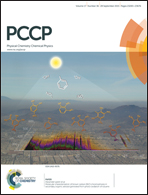The luminescence properties of heteroleptic [OsCl(CO)(N∩N)(P∩P)]+ complexes – radiative and non-radiative deactivation of the excited 3*MLCT state
Abstract
The luminescence properties of the heteroleptic [OsCl(CO)(N∩N)(P∩P)]+ complexes with bidentate phosphine P∩P and diimine N∩N ligands have been studied in acetonitrile solutions at room temperature and in methanol/ethanol (1 : 1) glasses at 77 K. At room temperature the investigated complexes feature strong (with the quantum yields ϕem from 0.17 up to 0.64), long-lived (with lifetimes τem in the range of 1.5–44.2 μs) 3*MLCT emission. Analysis of 3*MLCT emission band shapes leads to the quantities relevant for the radiative electron transfer (between the Os2+ central ion and the N∩N ligand) in the Marcus inverted region. It is also demonstrated that radiative kr and non-radiative knr decay rate constants of the excited 3*MLCT states can be interpreted within the Mulliken–Hush formalism. Especially values of knr rate constants can be predicted using the parameters available from the analysis of the radiative 1*MLCT ← S0 and 3*MLCT → S0 charge transfer processes.
![Graphical abstract: The luminescence properties of heteroleptic [OsCl(CO)(N∩N)(P∩P)]+ complexes – radiative and non-radiative deactivation of the excited 3*MLCT state](/en/Image/Get?imageInfo.ImageType=GA&imageInfo.ImageIdentifier.ManuscriptID=C5CP03299G&imageInfo.ImageIdentifier.Year=2015)

 Please wait while we load your content...
Please wait while we load your content...